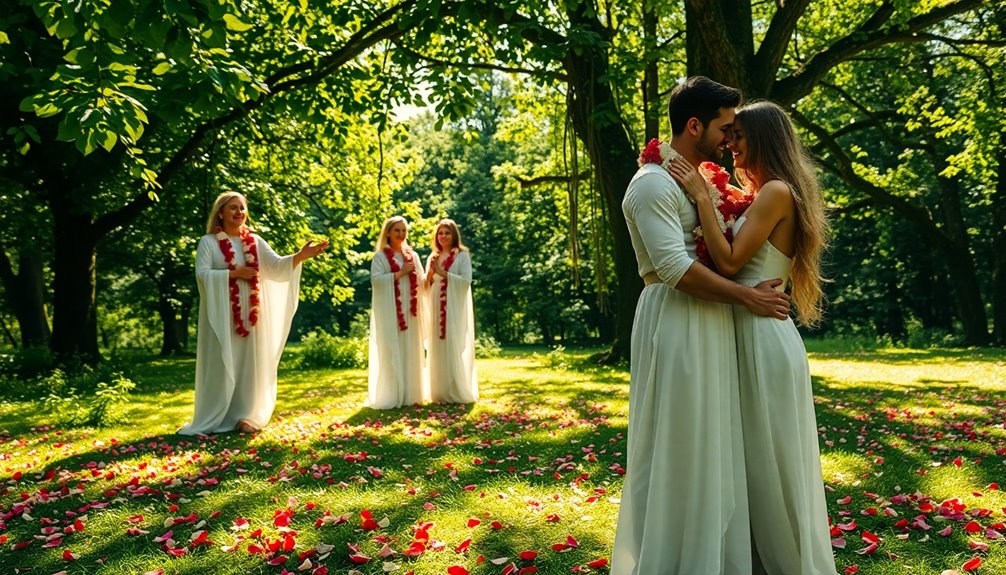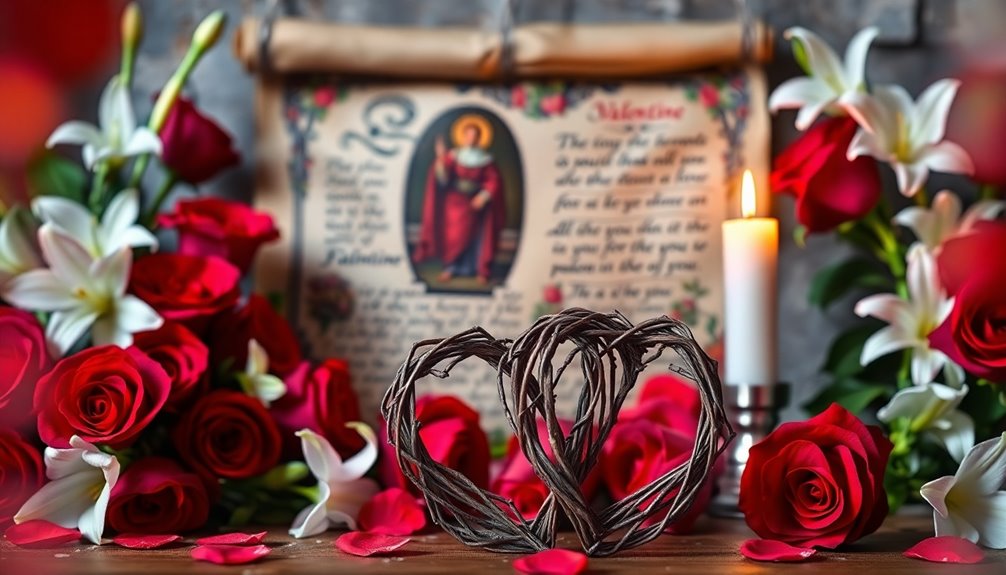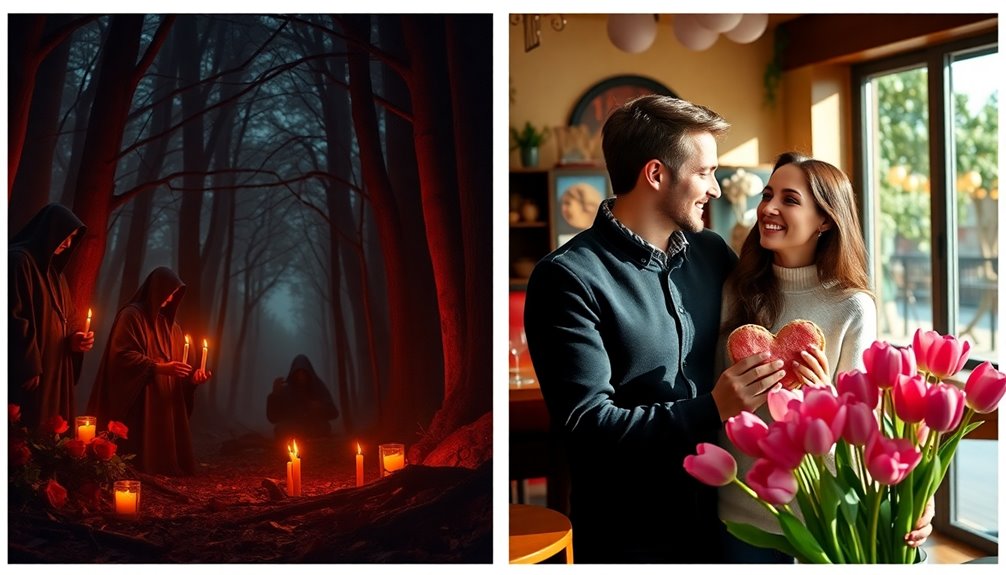Valentine's Day has really transformed over the centuries. It started as the Pagan Lupercalia festival, focusing on fertility rituals, and evolved into a Christian celebration of love named after St. Valentine. This priest secretly married couples in defiance of a marriage ban, leading to his martyrdom. Over time, the holiday embraced romantic literature, and now it reflects modern expressions of love through gifts and cards. If you're curious about its rich history, there's much more to discover!
Key Takeaways
- Valentine's Day originated from the ancient Roman festival Lupercalia, which celebrated fertility through rituals and matchmaking activities.
- Pope Gelasius I established February 14th as St. Valentine's Day in the 5th century, linking it to Christian martyrs.
- The legend of St. Valentine, who secretly married couples, contributed to the day's association with romantic love and commitment.
- Literary influences, particularly from Geoffrey Chaucer, popularized Valentine's Day as a day for romantic courtship and love letters.
- Today, Valentine's Day is a significant commercial holiday, with diverse gift-giving practices reflecting evolving cultural values around love and romance.
Historical Roots of Valentine's Day

Valentine's Day has deep historical roots that trace back to ancient Rome.
Originally, it was part of the Lupercalia festival, celebrated from February 13th to 15th, which aimed to promote fertility through playful rituals and animal sacrifices. This ancient Roman festival honored Faunus, the god of agriculture, and the legendary founders, Romulus and Remus.
In the 5th century, Pope Gelasius I established February 14th as St. Valentine's Day, linking it to Christian martyrs named Valentine. One such Valentine defied Emperor Claudius II's marriage ban, performing secret marriages that symbolized romantic love and commitment.
This shift from pagan celebrations to a Christian holiday marks a significant evolution of Valentine's Day, merging ancient traditions with new cultural practices over time.
The Transformation From Lupercalia to St. Valentine's Day

As the ancient Roman festival of Lupercalia waned, the emergence of St. Valentine's Day began to shape how you celebrate love.
Lupercalia, held from February 13th to 15th, featured fertility rituals that honored the god Faunus and included matchmaking lotteries.
In the 5th century, Pope Gelasius I established February 14th as a feast day for Christian martyrs named Valentine, intertwining the day with Christian values.
A significant legend tells of a priest who defied Emperor Claudius II's marriage ban, performing secret weddings and ultimately facing execution.
The Legend of St. Valentine and His Impact

While the tale of St. Valentine is rich with significance, it primarily centers around a Roman priest who defied Emperor Claudius II's marriage ban by secretly marrying couples. His act of love led to his arrest and execution around 270 CE. Valentine is also credited with healing the blind daughter of his jailer, which converted her family to Christianity. He famously sent her a note signed "from your Valentine," sparking the tradition of love notes. In 496 CE, Pope Gelasius I proclaimed February 14th as St. Valentine's Day, merging the legend with pagan festival roots, ultimately linking it to romantic love.
| Key Event | Year | Impact on Valentine's Day |
|---|---|---|
| Valentine's secret marriages | 270 CE | Initiated the legend of love |
| Healing the jailer's daughter | 270 CE | Fostered the tradition of compassion |
| Pope Gelasius I's proclamation | 496 CE | Established February 14th as a holiday |
| Blend with Lupercalia | Middle Ages | Linked to romantic affection |
| Chaucer's poetry | 14th Century | Solidified association with love |
Literary Influences on Valentine's Day Traditions

The rich history of Valentine's Day is deeply intertwined with literature, which has shaped how we celebrate love and affection.
Geoffrey Chaucer's 14th-century poem "Parliament of Fowls" first linked the day to romantic courtship, influencing how we see Valentine's Day today.
By the 18th century, the exchange of handwritten love notes became fashionable, paving the way for the tradition of giving Valentine's Day cards that express affection.
Literary influences further emerged with elaborate love letters and sonnets, popular among both nobility and commoners.
This passion for written romance inspired the mass production of Valentine's cards in the 19th century, driven by figures like Esther Howland, making romantic gestures more accessible through literary romanticism.
Modern Celebrations and Commercialization of Valentine's Day

Valentine's Day has transformed into a significant commercial holiday, drawing millions to indulge in expressions of love and appreciation. The commercialization of Valentine's Day is evident in the average spending per person, which reached $192.80 in 2023. From chocolates to men and romantic dinners, the diverse gift-giving practices reflect a cultural shift towards valuing experiences over material items. Countries worldwide celebrate unique customs, making it a global phenomenon.
| Gift Category | Percentage of Consumers |
|---|---|
| Candy | 57% |
| Greeting Cards | 40% |
| Flowers | 37% |
| Experiences | 32% |
| Chocolates to Men | N/A |
These evolving Valentine's Day celebrations showcase how love is expressed through both traditional and modern means.
Frequently Asked Questions
How Did Valentine's Day Become a Day of Romance?
Valentine's Day became a day of romance through a blend of ancient traditions and evolving cultural practices.
It started with fertility rites in ancient Rome, transforming over centuries to honor love and devotion.
You see, poets like Chaucer popularized the idea of romantic love on February 14th, while the exchange of love notes sparked in the 18th century.
What Are the Origins of Modern Valentine's Day?
Ever wondered how a day dedicated to love blossomed from ancient rituals?
Modern Valentine's Day traces back to the Roman festival Lupercalia, celebrating fertility with lively festivities.
Then, the Christianization of February 14th honored martyrs named Valentine, particularly one who secretly married couples.
Over time, poetry and the tradition of exchanging notes transformed this day into a romantic celebration, paving the way for the cards, chocolates, and flowers we cherish today.
How Did Lupercalia Become Valentine's Day?
Lupercalia transformed into Valentine's Day through a gradual process.
You'll find that this ancient Roman festival, celebrated from February 13th to 15th, focused on fertility and matchmaking.
As Christianity spread, Pope Gelasius I designated February 14th as St. Valentine's Day, connecting it to martyrdom.
Over time, the romantic aspects of Lupercalia merged with literary influences, particularly in the Middle Ages, solidifying the holiday as a celebration of love and affection we recognize today.
What Does the Bible Say About Valentine's Day?
Imagine a day filled with roses and heartfelt notes, yet the Bible doesn't directly mention Valentine's Day. Instead, it emphasizes love through passages like 1 Corinthians 13:4-7, highlighting patience and kindness.
While you celebrate romantic love, remember the Bible teaches about agape and philia, too. Many Christians use this day to express love aligned with biblical values, focusing on relationships and acts of kindness that reflect their faith.
Conclusion
As you reflect on Valentine's Day, consider how it evolved from ancient rituals to a modern celebration of love. While some might argue it's all about commercialism now, the roots in genuine connection and affection remain strong. The theory that love can be reduced to mere transactions overlooks the true spirit behind the day. So, whether you're sharing a heartfelt note or a simple gesture, remember: it's the thought and intention that truly matter in celebrating love.









